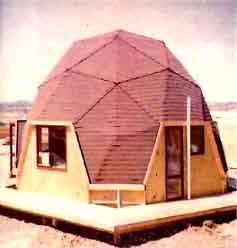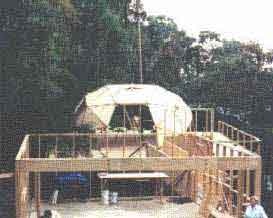 |
 |
|
|
 Harnett Dome, Drury, New Zealand
Squashed spheroid or oblate ellipsoid This 3v icoshedron was squashed in the aspect ratio of 0.618 (the golden ratio). The icosa face is shown, and the yellow shows that part of this 3v oblate ellipsoidal icosahedron which was used to build the Harnett Dome at Drury, near Auckland, New Zealand.
Stretched spheroid or prolate ellipsoid  
This 3v icosahedron was stretched and then rotated. It was truncated along a diagonal to allow for a mezzanine in the high end. The original icosa face is also shown. This was the basis of the Wilson dome at Pukekohe, near Auckland, New Zealand.
17mx12m 3v prolate ellipsoidal icosahedron
  An 11m (36 ft) diameter four frequency (4v) super-spheroidal icosahedron, rotated to give the mid-point of the original 1v icosa face as the zenith, as used for Mark, Jody & Indigo Verhoeven's dome home in Umina, NSW, Australia. The blue outlines the original icosa face, sub-divided to give a 4 v icosahedron. This dome was built using 75x50 timber (2"x3")  
The picture shows a 3v oblate super-ellipsoidal
icosahedron at the end of "Dome Day". The dome was erected using the pole
and lifting blocks with wire and adjusters. This dome was built in April
1998 for Ruth Sussman of Umina, New South Wales, Australia.


Free form amorphous
flow geodesic structure, Whangarei, N.Z.,theatre/restaurant.

Free form amorphous
flow of geodesic structure.
 This
picture shows a free form amorphous flow of geodesic structure combined
with a longitudinally cut egg, giving an elliptical floor plan with the
space spilling out one side. Thus free form, ellipsoidal and fragments
combine - a far cry from the 3v spheroid which seem to dominate peoples
thinking when it comes to geodesic domes. This
picture shows a free form amorphous flow of geodesic structure combined
with a longitudinally cut egg, giving an elliptical floor plan with the
space spilling out one side. Thus free form, ellipsoidal and fragments
combine - a far cry from the 3v spheroid which seem to dominate peoples
thinking when it comes to geodesic domes.
|